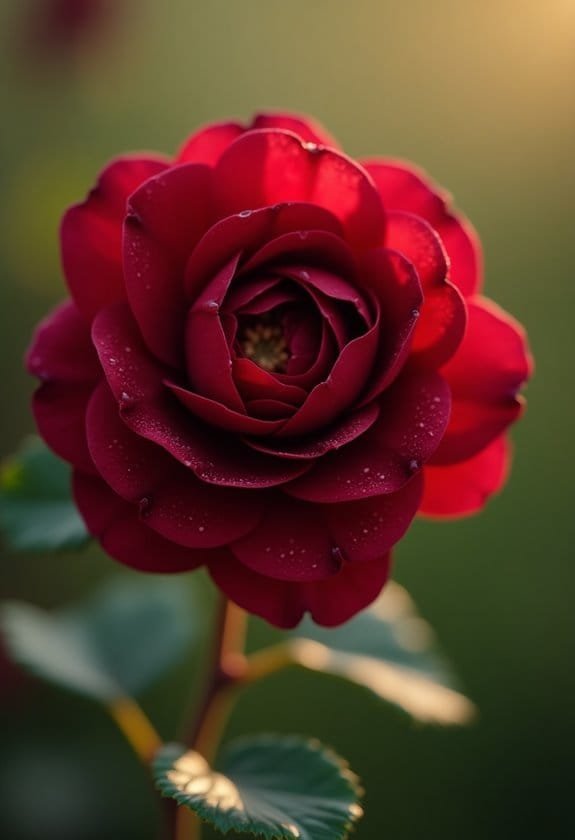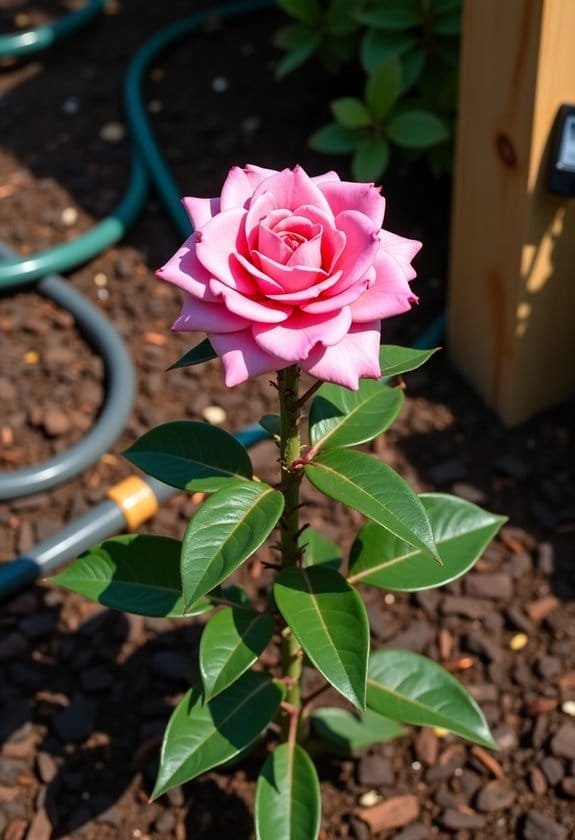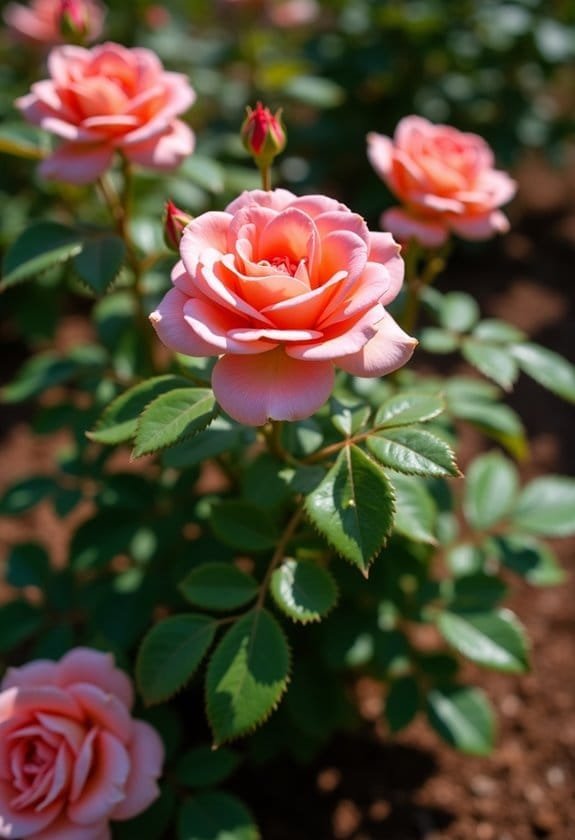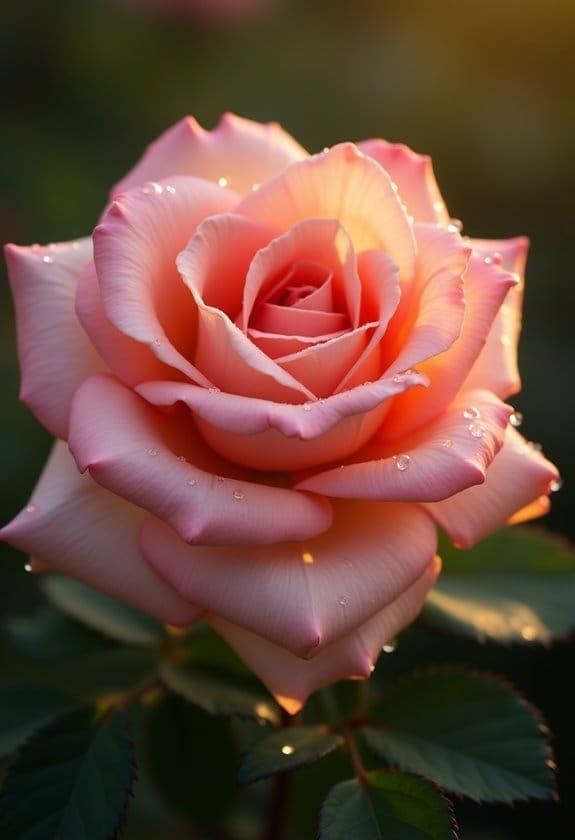Rosa species, encompassing over 300 wild varieties and 35,000 cultivars, represent nature's most celebrated flowering plants. These adaptable perennials thrive in temperate regions across USDA zones 4-10, requiring full sun exposure and well-draining soil with a pH of 6.0-6.8. The genus displays remarkable diversity in its five-petaled blooms, which range from pristine whites to deep crimsons, while featuring distinctive pinnate leaves and serrated leaflets. Today's roses stem from ancient cultivars like the fragrant Damask rose, contributing to their rich cultural significance in perfumery and medicine. Understanding these beloved plants' complex heritage reveals the secrets to their successful cultivation.
Main Points
- Rosa is a genus containing over 300 species and up to 35,000 cultivars, making it one of the most diverse flowering plant groups.
- The genus Rosa is divided into four subgenera: Hulthemia, Hesperrhodos, Platyrhodon, and Rosa, with eleven sections in subgenus Rosa.
- Rosa species typically feature five-petaled flowers in various colors, alternately arranged pinnate leaves, and nutrient-rich rose hips after blooming.
- Notable species include Rosa rugosa and Rosa gallica, known for their hardiness, historical significance, and use in perfumery and medicine.
- Rosa species thrive in temperate and subtropical regions, requiring full sunlight, well-draining soil, and temperatures between 60°F to 85°F.
Introduction

Roses, belonging to the genus Rosa, represent one of the most diverse and cultivated flowering plants in the world, encompassing more than 300 species and tens of thousands of cultivars.
These iconic woody perennials have flourished across temperate and subtropical regions of the Northern Hemisphere, where they display their characteristic large, showy blooms in an array of colors from pristine white to deep crimson.
The genus Rosa's remarkable adaptability and aesthetic appeal have led to its extensive cultivation throughout human history, resulting in an impressive collection of approximately 30,000 to 35,000 hybrids and cultivars that grace gardens worldwide.
Common Name
The genus Rosa encompasses what's commonly known as roses, representing over 300 species and thousands of cultivars that have captivated gardeners and flower enthusiasts worldwide.
These Rosa species have become deeply ingrained in human culture, with their common name "rose" being universally recognized across numerous languages and societies.
Garden roses, which comprise the majority of cultivated varieties, are distinguished by specific common names that reflect their growth habits and characteristics. Climbing roses scale walls and trellises, while miniature roses create delicate ground-level displays.
The diverse range includes hybrid teas, known for their classic single-stemmed blooms, and floribundas, which produce abundant flower clusters throughout the growing season. Each rose hip, the fruit that follows the flower, serves as a distinctive identifier for wild and cultivated varieties alike.
Beyond their ornamental designations, roses carry common names that echo their historical significance in perfumery and medicine.
The damask rose, for instance, bears a name that reflects its ancient origins and its enduring role in fragrance production, while species roses often retain names that reference their native habitats or discoverers.
Scientific Name
Botanical classification places *Rosa* as the foundational genus for all roses, encompassing over 300 distinct species within the family Rosaceae. This extensive genus demonstrates remarkable diversity through its taxonomic organization into several subgenera, including Hulthemia, Hesperrhodos, Platyrhodon, and the primary subgenus Rosa.
The systematic classification further divides the type subgenus Rosa into eleven distinct sections, reflecting the complex evolutionary relationships among different rose species. Notable members of the genus include *Rosa rugosa*, celebrated for its exceptional hardiness and aromatic blooms, and the historically significant *Rosa gallica* with its characteristic deep pink flowers.
Modern garden roses trace their lineage through intricate hybridization events that began in the 18th century, resulting in the vast array of cultivars known today. Recent genetic studies within the family Rosaceae have revealed fascinating insights into the genus's natural selection processes and DNA repair mechanisms.
These scientific investigations have also illuminated how hybridization events have contributed to the remarkable genetic diversity observed across Rosa species, enhancing our understanding of rose evolution and classification.
Overview
Within the remarkable Rosaceae family, members of the Rosa genus stand as iconic flowering plants that have captivated human interest for millennia. The genus encompasses over 300 distinct species and has given rise to tens of thousands of cultivars, showcasing nature's extraordinary capacity for variation and adaptation.
Rosa species have established themselves across vast geographical expanses, thriving in both temperate and subtropical regions throughout the Northern Hemisphere. Their characteristic flowers typically display five delicate petals arranged in intricate patterns, with colors ranging from pristine whites to vibrant reds and sunny yellows.
Beyond their renowned ornamental value, these plants produce nutrient-rich rose hips, berry-like fruits containing multiple seeds and substantial amounts of vitamin C.
Throughout history, roses have maintained their position as horticultural treasures, cultivated extensively for their aesthetic appeal and fragrant blooms. Their widespread distribution across North America, Europe, and Asia has contributed to their cultural significance, while their adaptability has enabled them to flourish in diverse environmental conditions, from garden settings to wild landscapes.
Key Features
Rosa species showcase remarkable diversity in their growth patterns, ranging from compact shrubs measuring just 30 centimeters to towering climbers that can extend beyond 12 meters in height.
These flowering plants display alternately arranged pinnate leaves with serrated leaflets, while their iconic blooms feature a distinctive five-petal arrangement in colors spanning from pure white to deep crimson.
Most Rosa species flower prolifically during late spring through early autumn, with some varieties offering repeated blooming cycles throughout the growing season, particularly in temperate climates.
Growth Size
Garden enthusiasts marvel at the diverse growth sizes exhibited by rose species, which range dramatically from compact 1-foot shrubs to towering climbers exceeding 20 feet in height.
These remarkable Rosa species demonstrate various growth habits, adapting to different garden settings with their spreading, upright, or trailing forms. The width of these versatile plants typically extends between 2 and 6 feet, creating opportunities for both space-efficient and expansive landscape designs.
Notable examples like Rosa californica illustrate the impressive vertical potential of certain species, reaching heights of up to 10 feet when provided with ideal growing conditions.
The plants' dimensional diversity allows gardeners to select specimens that perfectly suit their specific landscaping needs, from intimate cottage gardens to grand estate borders.
During their peak blooming period, which spans from late spring through early fall, these varying growth sizes create stunning vertical interest in the garden.
Many varieties exhibit recurrent blooming cycles throughout the summer months, maintaining their visual impact regardless of their size classification, while their distinct growth patterns contribute to the creation of layered garden designs that capitalize on both horizontal and vertical space.
Appearance
Nature's artistic palette comes to life in Rosa species, which showcase an impressive array of distinctive features across their varied forms. The flowers emerge in stunning displays of white, yellow, pink, and red, with each bloom characteristically presenting five petals arranged in sophisticated multiples of five.
The plant's foliage contributes greatly to its visual appeal, featuring alternately arranged pinnate leaves that stretch between 5 and 15 centimeters in length. These compound leaves typically display 3 to 9 serrated leaflets, creating an elegant green backdrop for the vibrant blooms.
Along the stems, sharp prickles serve as natural defense mechanisms, varying in both size and density among different Rosa species. These protective structures, often mistakenly called thorns, complement the plant's architectural form.
The culmination of the rose's reproductive cycle manifests in its berry-like fruits, known as rose hips, which develop into rich, colorful structures containing numerous seeds. This remarkable combination of features – from the symmetrical flowers to the protective prickles and nutritious fruits – exemplifies the sophisticated evolutionary adaptations of Rosa species.
Flowering Season
Throughout the growing season, roses display their remarkable blooming patterns, with most species producing flowers from late spring to early fall. The flowering duration varies considerably among different cultivars, as some varieties, particularly hybrid teas, produce a single magnificent flush of blooms, while others offer recurring cycles of flowers throughout the season.
Modern rose varieties have been carefully bred to extend their blooming periods, with many floribunda types providing continuous waves of blossoms during the growing months. These enhanced flowering patterns depend heavily on environmental conditions, particularly the amount of full sun exposure, which should be at least six hours daily for ideal bloom production.
The adaptation of roses across different hardiness zones, from USDA zones 4 through 10, influences their flowering schedules based on regional climate patterns. In warmer zones, roses might enjoy extended blooming periods, while those in cooler regions typically experience more concentrated flowering windows during peak summer months.
This versatility in flowering patterns has contributed to roses' enduring popularity, as gardeners can select varieties that align with their local growing conditions and desired blooming schedule.
Growing Requirements

Rosa species demand specific environmental conditions for best growth, with full sunlight exposure of at least six hours daily serving as a fundamental requirement.
These flowering plants flourish in well-draining, nutrient-rich soils that maintain a slightly acidic to neutral pH balance, which supports their extensive root systems and nutrient absorption capabilities.
The successful cultivation of roses hinges on consistent moisture levels through proper irrigation practices, while temperatures between 60°F and 85°F create ideal growing conditions for most varieties.
Light
When it comes to growing healthy roses, adequate sunlight stands as the most essential requirement for success. These beloved flowering plants demand a minimum of six hours of direct sunlight daily to achieve ideal growth and produce their signature blooms. The relationship between roses and sunlight exposure proves critical for developing robust stems and maintaining vibrant flower production throughout the growing season.
Proper sunlight placement greatly influences a rose's biological processes, particularly during the prime blooming period from late spring through early fall. While some varieties demonstrate resilience to drought conditions after establishment, they continue to rely heavily on consistent sun exposure for maintaining their health and liveliness.
The intense light not only supports efficient photosynthesis but also strengthens the plant's natural defense mechanisms against common diseases. Gardeners who position their roses in full-sun locations typically observe more luxuriant foliage development and stronger overall plant structure.
This strategic placement allows the plants to harness maximum solar energy, converting it into the resources needed for producing the spectacular floral displays that make roses such cherished garden specimens.
Soil
In addition to proper sunlight, roses demand specific soil conditions to reach their full potential. These elegant bloomers thrive in well-drained soil with a carefully balanced pH level ranging from 6.0 to 6.8, striking a delicate balance between slightly acidic and neutral conditions.
The foundation of successful rose cultivation lies in soil enrichment through organic matter, particularly compost, which serves as nature's own slow-release fertilizer system. This amendment not only enhances the soil's fertility but also creates an ideal environment for beneficial microorganisms, which work tirelessly to maintain soil health.
Deep, consistent moisture retention is vital, though the soil must never become waterlogged, as this can lead to devastating root rot issues.
Regular soil testing emerges as a significant practice for maintaining ideal growing conditions, allowing gardeners to make informed decisions about necessary amendments. The soil's composition functions like a living laboratory, where nutrient levels can be monitored and adjusted throughout the growing season.
This scientific approach to soil management guarantees that roses receive the precise balance of nutrients they need for robust growth and magnificent blooming.
Water
Throughout their growing season, roses demand a steady supply of water to produce their magnificent blooms. These resilient plants require approximately one inch of water weekly, whether from natural rainfall or supplemental irrigation, to maintain ideal growth conditions and guarantee robust flowering cycles.
Proper watering techniques play an essential role in preventing potential health issues that can compromise the plant's vigor. When irrigating roses, gardeners should direct water at the base of the plant while avoiding contact with the foliage, as wet leaves can become breeding grounds for destructive fungal diseases.
Newly planted specimens need particularly attentive moisture management until their root systems become well-established in the surrounding soil.
Monitoring soil moisture levels remains important for successful rose cultivation, as these plants thrive in conditions that strike a delicate balance between adequate hydration and proper drainage.
While established roses can tolerate brief periods of drought, consistent moisture levels support their long-term health and flowering potential. Gardeners should assess soil conditions regularly, adjusting their watering schedule to accommodate seasonal changes and varying environmental factors that might affect the plant's hydration needs.
Temperature
Temperature requirements play a significant role alongside proper hydration in rose cultivation. Different rose species have adapted to thrive within specific temperature ranges, with most varieties successfully growing in USDA hardiness zones 4 through 10. This broad adaptability demonstrates the remarkable versatility of roses across diverse climate conditions.
The relationship between temperature and rose health manifests most clearly during seasonal shifts. As winter approaches in colder regions, many rose varieties require protective measures to shield them from harsh freezing temperatures. Gardeners often employ techniques such as mulching around the base or wrapping plants in burlap to create a protective barrier against winter's bite.
When spring arrives, roses respond to rising temperatures by entering their growth phase, making this the ideal time for pruning and maintenance activities. The plants' temperature preferences also influence their sunlight requirements, as most rose species need at least six hours of direct sunlight daily to maintain proper metabolic functions and support abundant blooming.
This interaction between temperature and sunlight exposure creates a delicate balance that dedicated rose cultivators must carefully monitor.
Pollinator Criteria
Rosa species employ sophisticated visual and olfactory signals to attract essential pollinators, particularly bees, butterflies, and various beneficial insects.
The pollination process relies heavily on these winged visitors, who transfer pollen between flowers while foraging for nectar and pollen rewards within the blossoms.
Wild and single-flowered varieties prove especially effective at facilitating successful pollination, as their open, accessible structure allows pollinators to easily reach the reproductive parts of the flower, leading to the formation of rose hips containing viable seeds.
Attracted Pollinators
The natural allure of roses extends far beyond their aesthetic beauty, serving as powerful attractants for various pollinators in garden ecosystems. The flowers' open architecture, characterized by multiple layers of petals surrounding accessible reproductive structures, creates an ideal landing platform for diverse pollinating species, particularly bees, which are drawn to their vibrant colors and enticing fragrances.
Different rose species demonstrate varying degrees of pollinator attraction, with wild varieties like Rosa rugosa and Rosa multiflora proving especially effective at supporting local pollinator populations. These species produce abundant blooms throughout their flowering period, ensuring a consistent nectar source for beneficial insects.
The subsequent development of rose hips further enriches the ecological value of these plants by providing essential nutrition for birds and small mammals during colder seasons.
Garden designers often enhance roses' pollinator-attracting capabilities through strategic companion planting with nectar-rich species such as lavender and salvia. This thoughtful combination not only increases the diversity of visiting pollinators but also creates a more robust and sustainable garden ecosystem, where various species work in harmony to maintain natural pollination cycles.
Pollination Method
Natural pollination methods among roses showcase a fascinating interplay between floral anatomy and insect behavior. The process primarily depends on the strategic partnership between roses and their dedicated pollinators, especially bees, which navigate through the flower's intricate architecture of stamens and pistils while foraging for nectar.
The sophisticated pollination mechanism relies on the precise arrangement of reproductive structures within each bloom, where visiting insects inadvertently transfer pollen as they move between flowers. While some rose varieties can self-pollinate, cross-pollination between different specimens typically produces more vigorous offspring through enhanced genetic diversity.
The success of this process becomes evident in the formation of rose hips, which develop following successful fertilization events.
The evolutionary adaptations of roses have refined their pollination strategy through distinctly appealing characteristics. Their vibrant petals serve as visual beacons, while their complex fragrances act as chemical signals to guide potential pollinators.
This orchestrated system guarantees the continuation of rose species through generations, maintaining both wild populations and cultivated varieties through reliable reproductive mechanisms.
Care & Maintenance

Successful rose cultivation begins with selecting an ideal planting location that offers ample sunlight and well-draining soil, which establishes the foundation for robust growth.
Maintaining roses requires a consistent regimen of early spring pruning, strategic fertilization, and vigilant pest monitoring throughout the growing season.
Gardeners can enhance their rose gardens by incorporating compatible companion plants, such as lavender or catmint, which both attract beneficial pollinators and help naturally deter common rose pests.
Planting Tips
Growing roses successfully requires careful attention to their fundamental care requirements. When selecting a planting location, gardeners must prioritize areas that receive full sun, as roses need at least six hours of direct sunlight daily to produce their magnificent blooms.
The soil's composition plays an equally vital role, demanding well-drained soil enriched with organic matter to support healthy root development. Before planting, it's important to test the soil's pH level, which should range from slightly acidic to neutral for ideal nutrient absorption.
Experienced gardeners often incorporate compost or aged manure into the planting hole to improve soil structure and fertility. When positioning the plant, the graft union should be placed slightly below soil level in colder regions or at soil level in warmer climates.
To prune roses effectively, gardeners should wait until early spring, removing any winter-damaged or crossing branches to establish a strong foundation for growth. Proper spacing between plants is essential for adequate air circulation, which helps prevent common fungal diseases.
During the establishment period, consistent watering practices will encourage deep root development while avoiding oversaturation.
Ongoing Care
After establishing roses in the garden, ongoing maintenance becomes the vital aspect of their long-term success. Regular pruning in early spring serves as the foundation of rose care, removing dead wood and shaping the plant to encourage robust growth and abundant flowering throughout the season.
A systematic approach to watering proves necessary, with deep irrigation during dry periods allowing roots to develop properly while preventing moisture-related problems. The soil should dry slightly between waterings, and gardeners must avoid wetting the foliage to minimize disease risks.
Complementing proper hydration, a balanced rose fertilizer applied in early spring and mid-summer provides the necessary nutrients for ideal blooming and plant vigor.
Vigilant monitoring for pests and diseases remains essential for maintaining healthy roses. Common challenges include aphids and spider mites, along with fungal infections such as black spot and powdery mildew, which require prompt intervention when detected.
Regular deadheading of spent blooms not only maintains the garden's visual appeal but also redirects the plant's energy toward producing new flowers rather than seeds.
Suggested Companions
Companion planting strategies enhance the overall health and significance of roses while creating stunning garden compositions. Thoughtful plant selection provides multiple benefits, from natural pest control to improved aesthetic appeal throughout the growing season.
Lavender and alliums serve as excellent companions, actively deterring problematic aphids while contributing their own ornamental value to the garden space.
The integration of nepeta and salvia alongside roses creates a dynamic ecosystem that supports beneficial insects and enhances overall garden liveliness. These companion plants not only attract essential pollinators but also encourage predatory wasps that help maintain natural pest control.
Geraniums prove particularly valuable as companion plants, offering both weed suppression and visual interest through their robust blooms. The strategic placement of drought-tolerant companions helps create a more sustainable garden environment that requires less maintenance and water resources.
Additionally, proper companion planting improves air circulation between plants, which considerably enhances disease resistance by reducing the likelihood of common rose afflictions such as powdery mildew and black spot.
Common Issues
Rosa species face numerous challenges from both destructive pests and persistent diseases, with aphids, spider mites, and Japanese beetles ranking among the most problematic invaders.
These unwanted guests can swiftly compromise a rose garden's health through leaf damage, stunted growth, and weakened plant immunity.
Fortunately, gardeners can combat these issues through a combination of preventive measures, including regular monitoring, proper sanitation practices, and the strategic use of disease-resistant cultivars alongside organic pest control methods.
Pests/Diseases
Growing roses comes with a unique set of challenges from both pests and diseases that can impact their health and appearance. Common pests like aphids and Japanese beetles can wreak havoc on rose plants, with aphids causing leaf distortion and yellowing, while Japanese beetles systematically devour foliage, leaving behind skeletal remains.
Spider mites and rose thrips further compound these challenges, particularly during hot, dry spells when these invertebrates thrive.
On the disease front, black spot stands as one of the most persistent adversaries, creating distinctive dark lesions that often result in premature leaf drop.
Powdery mildew manifests as a ghostly white coating across leaves and stems, while Botrytis blight emerges during damp conditions to cause widespread wilting and browning. The appearance of rust's orange-brown pustules on leaf undersides signals yet another common affliction.
Successful rose cultivation demands vigilant monitoring and implementation of preventive measures, including proper plant spacing for adequate air circulation and the selection of disease-resistant varieties.
Regular inspection and immediate action upon discovering any signs of pests or diseases can help maintain the health and beauty of these beloved garden specimens.
Solutions
In addition to prevention, effective solutions exist for common rose growing challenges. Gardeners can implement a thorough pest management strategy that includes regular monitoring and targeted interventions when infestations occur, ensuring their roses remain vibrant and healthy throughout the growing season.
Strategic pruning serves as a foundational solution for many rose-related issues, as removing affected plant material helps combat both pests and diseases. When gardeners eliminate dead or diseased wood in early spring, they create an environment where roses can flourish with improved air circulation and renewed vigor.
Moreover, proper fertilizing techniques play an essential role in strengthening plants' natural defenses against various threats.
Environmental modifications often provide elegant solutions to persistent problems. Mulching around the base of rose plants not only protects against winter damage but also helps regulate soil moisture and temperature.
The installation of protective barriers, such as burlap wrapping in colder regions, safeguards vulnerable plants from frost damage, while maintaining good sanitation practices through systematic removal of fallen debris notably reduces disease pressure.
Summary

Among nature's most cherished flowering plants, roses encompass over 300 species and thousands of cultivars that showcase diverse colors, sizes, and fragrances. These remarkable Rosa species have adapted to various climates worldwide, demonstrating nature's extraordinary capacity for diversification and survival.
The genus has proven its versatility through notable examples like the hardy Rosa rugosa and the aromatic Rosa damascena, which continues to serve the perfume industry. Beyond their ornamental value, roses contribute considerably to both ecology and human use through their vitamin C-rich rose hips, which support wildlife and provide valuable ingredients for culinary applications.
These woody perennials thrive under specific conditions, requiring well-drained soil enriched with organic matter and abundant sunlight for ideal flowering.
Their cultural impact extends far beyond gardens, as roses have become deeply embedded in human traditions and symbolism across civilizations. Through careful cultivation and breeding, humanity has expanded the natural diversity of Rosa species into an astounding array of garden varieties, each contributing unique characteristics to this beloved genus.


